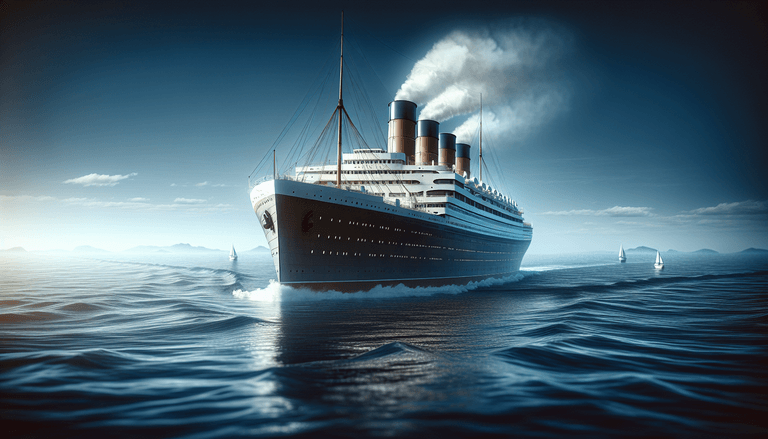Ahoy there, curious readers! Picture this: It's the early 20th century, the fashion is fabulously pre-flapper, and the world is abuzz with the marvel of the RMS Titanic. The largest and most luxurious ship ever constructed, a veritable floating palace of wood-panelled luxury and unbridled hubris, setting sail on her maiden voyage. But what if, dear reader, the Titanic had a not-so-unsinkable friend in technology's latest and greatest, the Global Positioning System, or GPS for short? Would history have been rewritten, or would the iceberg still have played its chilly hand?
Setting the Scene: The Unsinkable Dream
The Titanic was an epitome of Edwardian ambition, social stratification, and architectural magnificence. Imagine the who's who of society gathered on board, dressed to the nines, ready to dine, dance, and debate whether streaming video might one day replace vaudeville (the horror!). But as we all know, beneath the fanfare laid a tragedy waiting to unravel.
The Titanic's ill-fated journey across the Atlantic divulges significant lessons in both human fallibility and navigational pitfalls. The supposed unsinkable ship sailed on 10 April 1912, with hopes as high as its towering smokestacks. Yet, come 14 April, an icy adversary played spoiler. And thus, the tale of invincibility sunk into the annals of history.
Enter GPS: A Guide Through the Gloomy Atlantic
Now, let's hit the proverbial time-rewind button, adding a technological twist. Imagine Captain Edward Smith armed with a high-tech GPS, complete with voice navigation. A soothing guide voice, let’s say Benedict Cumberbatch in a calm, yet slightly dramatic tone, directing each nautical mile. "Approaching iceberg in 500 metres. Re-route recommended." Oh, what a different tale we might have told!
With GPS, the Titanic wouldn’t just have "set sail;"). It would have become the ship of tomorrow, today! Crunching those coordinates with subatomic precision, the crew could've navigated the North Atlantic with the placidity of a swan gliding across a pond. No more squinty-eyed lookouts staring into inky darkness or frantic Morse-coded messages relayed between ships. The Titanic would've glided past protruding icebergs like a synchronised swimmer at a splash-free Olympic event.
Wireless Woes Would be a Thing of the Past
As part of its multi-faceted offering, GPS comes with a precious extra: communication. Communicating with the wireless radio to gain last-known positions of dangerous icebergs was the Castaway-esque task of its day. A rudimentary system faltered in the face of relentless ice fields. With GPS, however, real-time updates and enhanced radar would transform a gripping drama into potentially a minor inconvenience, or, worse still, a case of captain’s boredom. "Lifeboat drills? Check. Evening tea plans? GPS is handling that, mate."
Able to relay position and heading with pinpoint accuracy, an ice-covered swathe of ocean could inexorably become the maritime equivalent of a pedestrian crossing, stop, look, listen, and carry on.
The Social Ripple Effect: From SOS to Selfie Obsessed
Beyond the technical advantages of evading icebergs, one can only imagine the cultural ripple effect on the ship's passengers. Word of the ship's secure route would travel faster than gossip at a dinner party. Relaxing passengers would post #Titanic_selfies with otherworldly calm, backs framed by an icy wonderland. Twitter would be ablaze with posts like "@Titanic_Sailor: Smooth sails and clear skies - Thanks, Benedict! #UnsinkableSafety"
With the navigation foibles averted, conversation might shift to other pressing matters: "Have you tried the Chateau Margaux on F Deck? Simply divine!" A shipboard life, characterised not by impending doom, but the serene and snap-happy passage across sea-lit social division.
Alternate Reality Conclusions: A Titanic Task
In the ever-entertaining realm of what-if history, the Titanic equipped with GPS jazzes up the past with a dose of nautical know-how. Add a touch of jest, dose of drama, and a dashing dash of storytelling magic, and voilà, one floating hotel turned safe and selfie-ready.
But alas, we remain anchored in reality. It's an episode for Tales That Never Were, a playful footnote in our historical experience. Yet, perhaps even in these musings, a morsel of truth lingers: History might not have to repeat itself, for technology marches onward, steering us clearer of our metaphorical icebergs.







